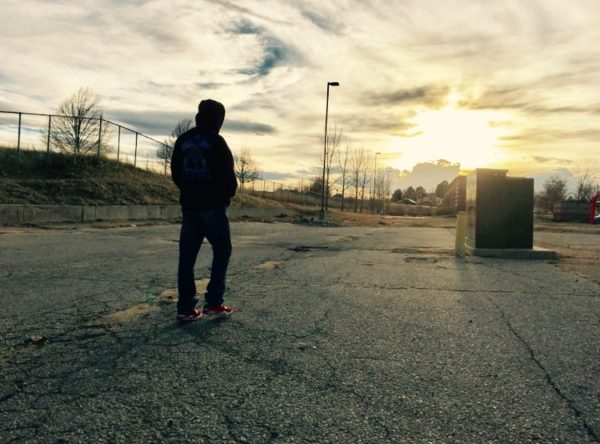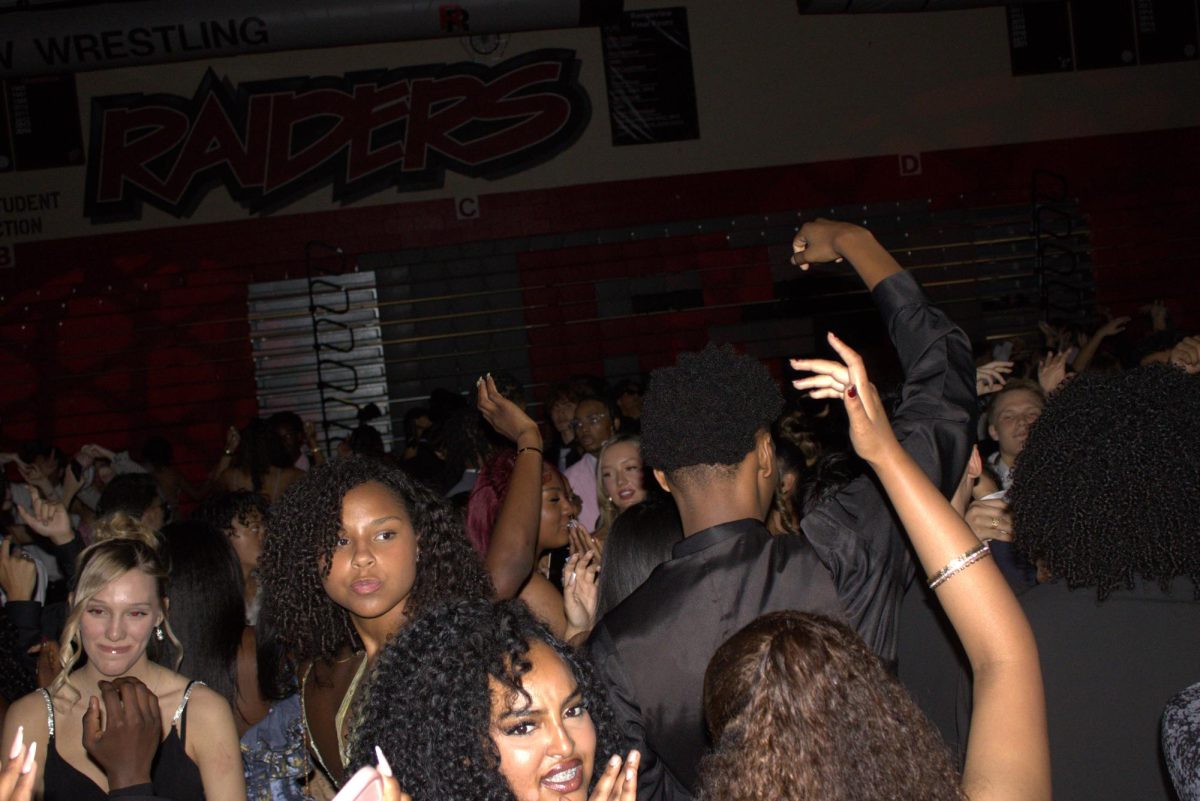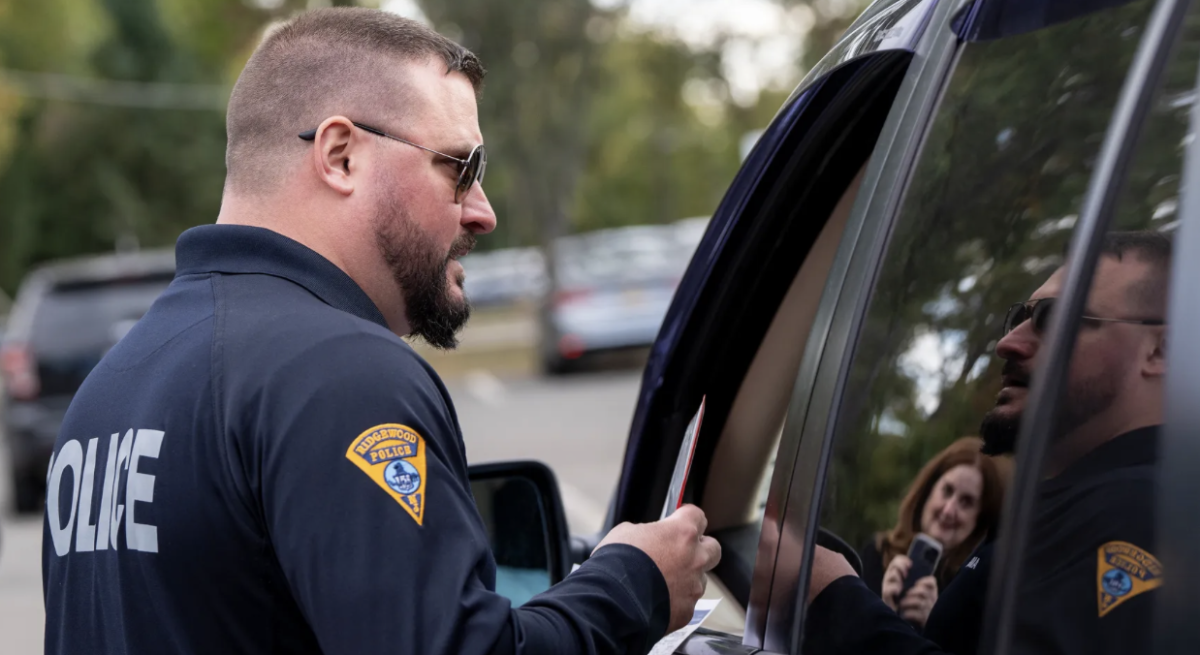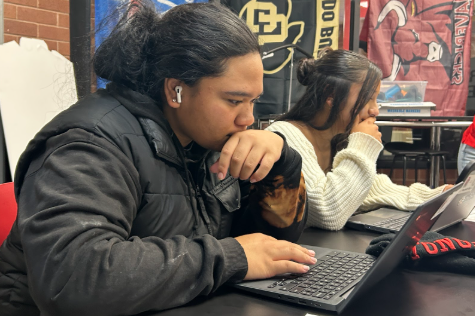Feature photo by: Savannah Lyman- A teenager began to walk home after school. In the United States, 40% of the homeless population are under the age of 18.
EDITOR’S NOTE: Several of the names of the RHS students interviewed for this story have been changed to protect their identity; they do not want to have the stigma of being homeless.
It’s a brand new day at Rangeview High School. You’re walking up the stairs and into the entrance. You say “hi” to your friends and they compliment the new shoes you got. You roll your eyes and begin to tell them they weren’t the pair you actually wanted. You say that your mom wouldn’t give you the money to buy them.
Little did you know, the girl you just passed recently ran away from home. She’ll be sleeping on a bench for the night with the clothes on her back and a couple of dollars in her pocket.
That annoying guy who bumped into you? He has been without a stable home for six months. He’s selling illegal drugs just to put food on the table for him and his little sister.
That really sweet girl in math who always smiles but never talks? She’s been couch surfing ever since her father raped her, and her mom was too drunk to care.

Youth homelessness is a more common thing than many people would care to believe. Right here at Rangeview High School, at least 30 students are considered to be homeless, based on information provided by students to the school, but the actual number is likely much higher because many kids and families are too embarrassed to report being homeless.
According to the Covenant House — a nonprofit that focuses on homeless teens — every year more than two million kids and teens in the U.S. will come across issues with homelessness. This will later bleed into their adult lives, and they will continue struggling with money, and this can become a drain on their local community in many ways.
From witnessing murder to being raped or kicked out, many RHS students have been lucky enough to never experience the everyday traumas of homeless students. But more than a handful of students here at Rangeview have and still are struggling to live an “average life” that most RHS students take for granted, let alone have a full meal in their bellies throughout the day. Below are some of RHS students talk about their experiences being homeless; names have been changed due to not wanting to be embarrassed or known.
“I remember being little and not really knowing what was actually happening,” says Kim, a Rangeview junior. “My mom was always stressed out working for hours, and I never really got to see her. My dad worked at night… my sister and I were always together and my brother was off doing his own thing.”
Moving from hotel to hotel, Kim says she was never able to go to school. If she did, she was late and struggled in class.
“I would go to the fridge and there wouldn’t be any food except maybe a week old bowl of pasta and that’s a maybe,” says Kim. “My siblings always told me about when we were ‘street homeless’ and how we lived in a van for a little while…I was told one time we couldn’t afford a hotel so we were bathed in a local river.”
Kim’s brother and sister got old enough to move out as she was still too little to do anything. She continued to struggle for a little while. There came a day social services got a hold of her and she immediately went into foster care.
Considering all the struggles Kim has been through, this doesn’t discourage her but motivates her instead.
“I’m good now and I have everything I could ever need, but that will always be a part of my story. It’s the reason I work so hard in school — so I never have to struggle.”
Facts and statistics:
According to https://www.covenanthouse.org/homeless-teen-issues/statistics
- In the United States, 40% of the homeless population are under the age of 18.
- 57% of teenagers in the U.S. go without food at least one day every month.
- 25% of foster care children who have left the system have become homeless only after four months.
- 50% of these kids coming out of foster care and juvenile justice systems will be homeless within six months due to no family or friend support and limited knowledge.
“My landlord called the cops they came and took [my brother and I] away from my mom and dad,” says Jack, a Rangeview sophomore.
Jack has been in foster care since he was 14 years old. He switched from home to home for a few years until he finally landed in a group home.

“My mom told me she didn’t want me back in the house, so I went back in foster care. I went to this really mean lady’s house,” says Jack. “She made me eat in my room cause I didn’t know how to eat in front of people. I wasn’t able to make friends or talk to anyone for the longest unless I was at school, but I ran away from her house. I was on the run for a two months, then I turned myself in. I was locked up for a month and a half, then I went to this group home [which] I’m in right now.”
Jack’s experiences are not uncommon for a foster care child, but foster care children and juvenile justice system children are not the only ones at risk of being put on the streets.
According to https://www.dosomething.org/us/facts/11-facts-about-homeless-teens
- 40% of these homeless teens identify themselves as LGBT. Family rejections based on sexual and gender identity is the most contributing factor to youth homelessness which is 46%.
- A study issued in 2014 says 45,205 children are without a guardian and are left to take care of themselves in the U.S. alone.
- Estimates from the Urban Institute: 1 in 5 kids who are under the age of 18 will eventually run away at least once.
- 41% of kids who are runaway are abandoned by parents within 24 hours and 43% are abused by their caretakers
With these statistics in mind, founder of Denver Street Schools, Tom Tillapaugh, adds a passionate thought to the topic.
“Homelessness is not the issue but it’s a consequence,” says Tillapaugh. “If a child is homeless, I blame the parents.”
Denver Street Schools (DSS) gives teens who struggle with money a second chance at a solid education. Tillapaugh has a burning passion for helping those who are willing to take it.
“DSS gives these kids education so they can have knowledge and not be ignorant,” stated Tillapaugh. “I started this because they have everything for homeless people except for a school. I feel bad for them because of their circumstances and self problems but not because they are homeless. Recognize the fact that there are roots to homelessness; there are reasons for people to be homeless.”
Things aren’t always as they seem in today’s world. Within youth homelessness, the dangers that come with this lifestyle put many people at risk.
“I had to be a parent to these kids; I took them in. Not everyone has a dad with ambitions for their daughter,” Tillapaugh says. “Many dads rape their kids and moms have sold their daughters into sex trafficking.”
Even though a lot of kids do not choose this lifestyle, a select few do. According to Tillapaugh, he considers one of the main factors of homelessness is your typical modern day teen; rebellion and no one telling them what to do.
Causes:
According to https://www.dosomething.org/us/facts/11-facts-about-homeless-teens
- 50% of young people out on their own say that their parents kicked them out or they wanted to be on their own despite what their future holds.
- In 2002, a study from the Department of Health and Human Services reports 21-40% homeless runaways have been sexually abused
- Approximately 20,000 adolescents are pressured and often times forced into prostitution in order to make a living.
- 50% of youth that are in shelters have reported that they have been a victim of conflicts and severe physical harm which is the reason they are without a home.

Rangeview student flaunts their new $200 Timberlands. According to feedingamerica.org, a study in 2015 showed 6.3 million households have dealt with little to no food. (Savannah Lyman)
“One of the big issues we’re facing is cost of living increase. We need to be aware of what’s going on and also be involved.” says Paul Prosise who works for the Denver Rescue Mission.
When kids are without a home, no matter the reason, there are always consequences.
Effects:
According to dosomething.org and covenanthouse.org
- Many homeless people suffer from mental health problems preventing them from maintaining stable relationships
- HIV/AID rates are 3 to 9 times higher in the homeless population
- They also have low self esteem and tend to have angry outbursts
Youth homelessness is something society brushes under the rug and a lot of people choose to ignore. Not only do they go without a home or food but education is also put at risk.
“My mom told me that my dad had…apparently married and he had way more women than my mother. Not only that, but he had abused my mother when I was around 10 or 11,” says Anna, a Rangeview junior. “We [had] moved… a couple weeks later, my aunt and uncle kicked us all out, knowing we had nowhere else to go. Four months later…we drove back to Colorado where we stayed with my mom’s friend and she had awful kids — and I mean awful.”
Anna and her family struggled with finding a stable home. They have jumped from family member to friend many times before officially having a home.
“In 8th grade, my dad was shot more than 12 times. My mom took me out of [school] for awhile and we stayed with my grandmother,” says Anna. “We came back but we didn’t have anywhere to stay… then we had found a place but we were still having money problems.”
Through all the heartache and struggle, Anna says her mom is the reason she had hope for a better future.
“I never forget what happened when I look out on the street; I think that could have been me. I could be in hunger and not have anything,” says Anna.
According to http://nationalhomeless.org/issues/youth/ of the kids who are homeless or runaways, 75% of them are drop outs.
“It’s messed up and I hate it,” says junior Samantha Hartmen when asked about all of the homeless student at RHS and in the local community. “[We should] go easy on the kids who don’t have homes…help those who don’t have money.”
If you or someone you know is struggling with homelessness, here are some sources you can go to for help.
- National Youth Crisis Helpline: 1-800-999-9999
https://www.covenanthouse.org/homeless-youth-programs/NINELINE
- Urban Peak: www.urbanpeak.com
- LGBT runaway help: http://www.glbthotline.org/






